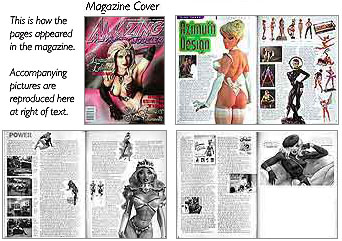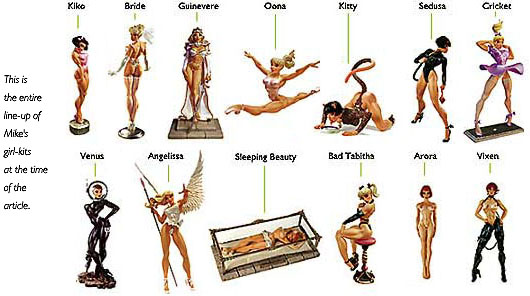|
An Interview by Frederick Allen / AFM
I N T R O D U C T I O N:
Most of us know Mike James as the creator of compelling
pinups-not only his garage kits of global fame, but also companion
artworks, drawings, paintings, and photographs. We also know
Mike as the owner/sculptor of Azimuth Design, the creator of
a dynamic series of pinup ads in publications like Amazing Figure
Modeler, and the proprietor of the most elegant garage kit website
in the business. We know him as a 21st century heir to the great
pinup artists like George Petty and Gil Elvgren.
But Mike is a totally different kind of artist as well. Under
another name, he's part of the serious world of contemporary
art, where he's far better known than he is as a pinup artist.
When I was asked to interview Mike, I thought it would be fun
to talk about both sides of his art. But Mike prefers to keep
his two art worlds totally separate, and maybe he's right.
I first met Mike at his home/studio in NYC in 1995. At that time,
his "fine art" career was in full swing. Represented
by a major New York gallery, he was flying around installing
one-man shows in some of America's major art museums. His work
was being reviewed in ArtNews, Artweek, Art in America, and The
New York Times. His work is in the permanent collection of the
Museum of Modern Art. Even now, this fine art career continues
simultaneously with his kit business.
Mike's resume is impressive with three post-graduate degrees
in art and lots of awards. He's paid to lecture about his art
at places like the Rhode Island School of Design. He was short
listed to design the opening ceremonies at the 1996 Atlanta Olympics.
He once drove straight from delivering a lecture at Harvard University
to setting up his booth at Chiller Theater.
That said, if you meet Mike at model shows, you'll never hear
about his other life, because he rarely tells anyone. He's a
regular, friendly guy who just happens to create phenomenal girl
art.
FA:
So tell me. With all this going on, how did you come across garage
kits?
MJ: By accident. One rare free weekend in the early '90s,
I was wandering around New York's Chinatown and stumbled into
a tiny model shop, where I found some resin sculptures in crappy
boxes. I took two home and built them, modifying them to suit
my tastes. It was purely for fun at the time.
FA: How did this lead to doing kits as a business? And
where did the name "Azimuth Design" come from?
MJ: I was modifying my build-ups quite a bit. I thought
maybe I should attempt making one from scratch. I made the first
one just for myself. I bought some Super-Sculpey at Pearl Paint
and started a devil girl. I already knew armature clay sculpting
from my student days. As for the name "Azimuth Design,"
it actually existed before the kits. It was a company I'd started
in the late '80s for doing freelance design for various New York
City ad agencies. Once I'd decided to sell my first kit, I just
used that name, for tax purposes. It never occurred to me to
come up with a more appropo name.
FA: So you started a kit business using your design firm's
name?
MJ: The kit biz occurred almost by accident, too. A friend
came over to our loft and saw my devil girl on the layout table
and said, "Cool. I want one." In order to make him
a copy, I started researching mold making. I knew traditional
moldmaking and casting techniques, but decided to place some
calls to people in the kit-making field, to see how they did
it. Finally, John Wright of Vision Models, whose kits I'd bought
and loved, was gracious enough to help me out. I'm indebted to
John for that. I credit him with getting me started. Anyway,
I'd made my first kit molds, and cast two copies, one for me
and one for my friend. Then I realized I had this expensive mold
sitting around, good for at least 30 more casts. So I took an
ad out in a major kit mag for "Sedusa, the Devil's Daughter,"
and I was off and running.
FA: That seems almost serendipitous.
MJ: (grinning) There was no dipping involved; you "pour"
the resin. Seriously though, "Sedusa" sold 50 kits
in 2 months, enough to fund new molds and allow me to start a
second kit, "Angelissa"-Sedusa's "good girl"
twin sister. After Angelissa sold okay I said, "Wow, this
is not only fun; this is somewhat profitable."
FA: So you got into kits for the fabulous wealth.
MJ: Ha, yeah that, the paparazzi, and the groupies.
No really, I saw this gaping hole. Flipping through Terry Webb's
catalog The Garage Kit that Ate My Wallet, I noticed there
were not many girl kits. Except for Japanese Anime kits (which
I love), there were only a handful. Clay Moore had a super Vampirella,
John [Wright] had a few beautiful girl kits, Jim Fawkes had a
few, and Mike Cusanelli had a couple via Soldat. But it seemed
to me that no one was really taking on girl kits exclusively,
or in a big way. So I saw an opening in the hobby.
After Angelissa did okay, I announced publicly that Azimuth Design
was going to do a girl kit "line." And that's ALL we
would do-just girl kits.
FA: Your girl kits seemed to capture the modeling community's
attention right off. You have a strong style. Do you think that
style recognizability has anything do to with it?
MJ: I first became aware of that at a kit convention,
I asked a friend to go see if any of my kits were entered in
the model contest room. I was busy downstairs setting up as a
vendor. He came back saying, "It's too crowded. I could
only scan the room from tiptoe through the double doors. It looks
like two of yours are there, but I've never seen them before."
He had described "Cricket" and "Agent Venus",
recognizing my kits by styling alone, and from across a crowded
room.
FA: I don't think there's anyone else in the hobby with
such a recognizable and strong style. Where did your style come
from?
MJ: I'm not sure exactly. It's just me. I like drawing
fit, shapely girls. I like expressive body languge and animation-style
art. I suppose it comes from what I've seen and liked, as processed
through my own somewhat skewed brainpan.
FA: Skewed brainpan aside, who specifically are your
figurative influences?
MJ: That ranges widely. Classical figure painters like
Botticelli and Ingres for their lovely and gentle view of feminine
beauty and crisp contour line. The comic giant Jack Kirby for
sheer graphic power and meaningful posing. I mean, look at his
awesomely regal Silver Surfer. My Angelissa kit was, at best,
a weak attempt to achieve that level of quiet power. Classic
American pinup artists George Petty and Gil Elvgren for that
innocent girl-next-door quality. I worship regularly at the alter
of Elvgren. The lovely faces and deceptively succubous charm
of Disney girls. I still maintain Disney animators include a
slightly coercive sexual thing in even their sweetest female
characterizations. Female musculature as depicted in much current
comic book art, female fitness competitions on TV, Latin ballroom
dancing, and Olympic gymnasts. There is just so much. And, of
course, there are my own ideas.
FA: Let's talk about what you bring to the mix. You seem
to have this hyper-sexual appeal evident in all your characters.
Where does that come from?
MJ: That goes way back. I was brought up Roman Catholic,
meaning "repressed". No doubt I'm still working through
all that sexual denial. I developed fantasies about girls early
on because of that. I recall one particular dream I had as a
young boy, of a flying saucer.
It had landed in our backyard. I dreamed I crawled out of bed,
peeked over the windowsill to watch the saucer door open. Somehow,
I knew I was going to be abducted. Breathless for the first view
of my captors, my repressed, pre-teen libido must have kicked
in and conjured the aliens that IT most wanted to see. Because
stepping out from the light came these five barely clad sexual
"goddesses". They were just unbelievable, more beautiful,
more graceful, and sexier by far than anything I'd ever even
dared imagine. The id at full bore.
That's powerful, significant stuff. I access the id when designing
figures today, and that means putting in a generous amount of
"tease". But I realize that showing "a bit of
stocking and garter" as Elvgren did, wouldn't cut it as
tease today. In this world, where girls at the mall can be seen
wearing low-cut hiphuggers with the sides of their panties strung
up over their hips, you're gonna' have to push it a little further
than the pinup masters did. Frankly, you know when it's about
right when it makes someone a little uneasy, then you know your
not rehashing already-accepted ideas, but finding the new edge.
As one of my painting teacher's said, "If someone's not
bitching about your taste, then you're not doing your job."
But you've got to do more than just push boundaries. "Ideas"
are important.
For me it's "duality"- good and bad inhabiting the
same person. I want those Disney-sweet faces sitting on those
made-for-sin bodies. I want that irritating tension between sweet
and naughty. This Yin-Yang thing. Where you're caught between
lust, where you just want to ravage them, and gentle love, where
you want to just powder 'em up and tuck 'em in the for the night.
Get that balance right and you create this "aggravation"
that ping-pongs back and forth in the head, building steam. If
a guy's ever known a girl he just couldn't get off his mind,
nine times out of ten that's due to just such irritating yin-yang
friction. You can ramp that duality up in fantasy art.
FA: Is that why you never sculpt real people?
MJ: Yeah. I find reality to be a rather limiting template.
No girl gets tummy muscles that could crack walnuts without losing
voluptuous breast tissue. And if I think two sets of upper abdominals
is sexier than three, then I'll sculpt that. Also, I don't sculpt
"pre-existing" fictional characters. That's a costly
decision because this hobby is primarilly a "fan" base.
But as an artist and character generator myself, sculpting another's
creation is unfulfilling. And for those always urging me to sculpt
a warrior princess or Vamp....puh-leese! How many vampire girls,
warriors with swords, and girls with guns do we need? Others
are filling that need very well, beyond the need, in fact. I'm
deliberately searching for alternatives to that. I need something
fresh. Ironically, I'm looking to the past to get it.
FA: You seem to do a lot of things other kit companies
don't. For example, you don't sell in stores.
MJ: Yup...I'm completely alone in this hobby in that
regard - Azimuth Design is direct mail company only.
FA: Why do you do it that way?
MJ: Cuz I get to talk to modelers instead of storeowners.
I like talking to modelers. They're often creative and enthusiastic.
Also, I like "direct" feedback - not just the praise
- modelers aren't shy about telling you things you'd prefer not
to hear, and that's invaluable information. However, not having
one's kits on stores shelves is a terrible sales and visibility
handicap. I counter that lack of visibility with a lot of print
ads. Nearly a third of our profits go to
print worldwide. And the web pages help a lot with visibility
and sales. More than half my kit sales are from jamesart.com.
FA: Frankly, I think your web pages are the best kit-company
web pages in the world - countless pages of nothing but pretty
girls. Very clean. And ALL content - no hype, no links, no baloney.
They load and navigate like a dream. I notice this year you redesigned
it and added drawing, photography, and even canvas painting categories.
MJ: I sculpt kits, but I don't consider myself solely
a kit sculptor. As I said, I have this idea of a little different
type of female. As an exploring artist, I'll use any medium that
facilitates the development of that idea. It's idea based, not
medium based. I don't really see my job as "product"
creation. I'm trying to develop a personal vision of femininity
and put that out, however I can.
FA: Your photos look like your kits. Where do you find
the girls to model for your kits?
MJ: You mean girls that are buff, sweet-faced, and 12
inches tall? The thing that I apparently will NEVER convince
anyone of, is that my photography of girls has no link whatsoever
with my sculpture. I have never used a live model for either
a drawing, or to pose for any kit. I sculpt only from my drawings,
and the kit drawings are from my head, most often without reference
of any sort. It's confusing, partly because of the general assumption
that figurative artists "require" real-life reference
to sculpt. Some do maybe, I don't, at least for this style. And
partly, too, it's my own fault. At kit shows, I've dressed real
girls up to look like my kits in order to help me sell them.
Folks always assume, of course, that these girls were the models
for the kits. But the kits always come first. In fact, I didn't
start shooting photos until three years ago, when over half the
kit line was already complete.
Also, I don't think people get that I'm "imposing"
my same style on the photos as the kits. First, actively seeking
out girls that have that same innocent quality of the kits -
sweet faces, and fit, voluptuous bodies. Secondly, tweaking the
heck out of the pictures in Photoshop, often for days, to make
them look even more like my style. The result is basically a
photo/illustration, crafted enough to look unaltered. So, of
course the girls - lovely as they are-get all the credit. Though
I'm pulling arms from one pic, pasting it on another, stretching
legs, pushing out chests, switching heads, and retouching the
collage of parts, people tend to assume,"No 'art' here,
he just snapped a picture."
FA: You also created comic books for your early kit characters.
MJ: The comics helped bring my characters to life. After
all, I'm not sculpting Batgirl, or someone whose back story everyone
knows, so I had to create the stories to generate interest. I
try to do everything I can to make the kits, drawings, and photos
seem more alive. For instance, in the kit instructions, I refer
to the kits as "she." I want modelers to develop some
sort of caring connection with their kits.
FA: Your instructions are probably the most detailed
and fun to read in the business. And they're available on your
website.
MJ: I try to be complete and entertaining, and to make
the whole kit process fun. Well written and illustrated instructions
help "animate" the kit, so that it becomes almost like
a pet. Something special.
With regard to further "animation" of my ideas, I am
itching to shoot some little ten-minute videos for the arrival
of web broadband. Broadband will afford line speeds capable of
downloading fairly sharp video. I want to establish a pay-per-view
credit card thing where for a buck you get to download a ten-minute
video. Maybe a new one every month. I won't elaborate on content,
but I think what I have in mind will work and be a great addition
to the other girl art.
FA: I'm curious. After 15 years of NYC, why did you move
to the deep woods of Pennsylvania?
MJ: I needed to get away from all the hubbub, and I had
a perfect opportunity to do that.
In 1994, I made a bit of dough designing the world's largest
website - General Electric's. It was a real coup - we beat out
all the big agencies. At 330,000 webpages, a 6 million dollar
account. As I was only freelancing as head designer, they gave
me a nice package, and I cut out. It allowed me to build the
studio of my dreams here in the woods with cash. 15 acres and
a 20-acre beaver pond, no neighbors. And it's beautiful here
all year round, very conducive to the quiet introspection art
demands. After the madness of Manhattan, a no-brainer.
FA: Back to kits. What's in the future there?
MJ: Honestly, I never know until I'm bending armature
wire - sometimes, not even then. I've got an entire file drawer
of drawings for kit poses and characters. When it comes time
for a new kit, I lay out hundreds of drawings, cull the top ten,
and basically shut my eyes and throw a dart, because at that
point I think they're all fairly good ideas. But the character
can still change, even during the process of finish sculpting.
FA: Do you think this idea of archetyping and character
creation could be responsible to your longevity in the hobby?
MJ: (laughs) It's funny to think of 7 or 8 years as longevity.
I've got lint in my bellybutton older than that. But it's true
a lot of major kit companies folded in '98, and we weathered
that. I attribute our survival to a few things.
One, we have a really recognizable and distinct style that you
can't get anywhere else. Two, right out of the gate we defined
a niche - girl kits, and only girl kits. When people say, "Where
can I go to see girl kits?" I want Azimuth to be the first
name that pops into their heads. Narrowing your focus in a market
already glutted with product is a good business model. Third,
we advertise like crazy.
And number four-the biggie. We defend our copyrights. In 1998,
when illegal recasting hit its peak, we went into the red and
gave every dime we made that year to our copyright law firm.
We took a huge hit financially, but we shut out a LOT of the
recasting of our kits, both the manufacturers that made them
and the stores that carried them. Just recently, we were awarded
damages on a successful litigation over copyright infringement
overseas. It cost us a lot to get that remedy, but it made us
feel good. However, the real value of defensive litigation is
that the word gets out to the thieves that Azimuth Design is
a "sumbitch" when it comes to protecting their intellectual
property.
FA: Got it. So where from here?
MJ: Well, I'm continuing the "fine art" work
- an exhibition coming up in Connecticut soon. My wife Sandy
is up to her eyeballs designing for her NYC clients, so I'm trying
to help out there. It's the usual thing, juggling three careers.
My close friends find it weird that I compartmentalize my creative
efforts; fine art / girl art / commercial design. But it's oddly
helpful. The separation clears cobwebs. The fine art and the
design work helps with the kit stuff by giving me the "girl
break" I need to regain objectivity, and vice versa. And
dealing with wholly different types of folks keeps life pretty
interesting and fun.
As for garage kits, of course I don't know what the next kit
is. But I'll continue to create kits for as long as the endeavor
is tenable. Sometimes I feel I've barely scratched the surface
there yet. I need to get two more canvases done. It's fun to
bristle brush paint again. I've got a couple of dozen new drawings
and photos prepared to put on the web pages when I get a shot
to open the html. And I just GOTTA get this deck on the back
of the house done! It's been a year in the doing. (smiling) Maybe
I can put Tina in a bikini and tool belt and kill two birds with
one stone.
FA: That's certainly a good mental image to close on
- maybe I'll find it on your webpages soon. .... I thank you
for your time, Mike.
THE END
|
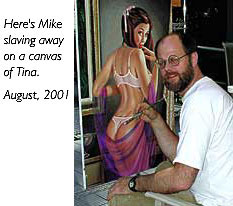
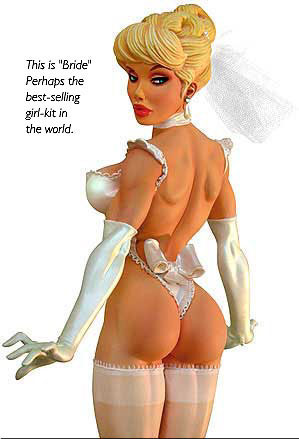

Samples of Mike's Photography
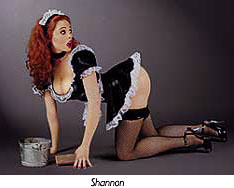
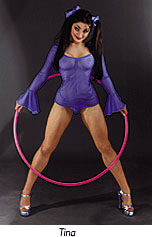
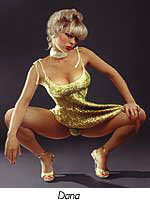
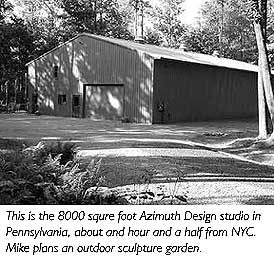
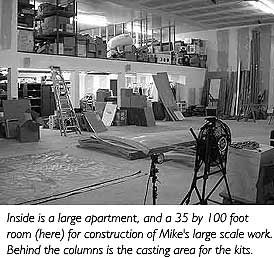
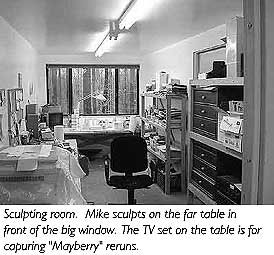
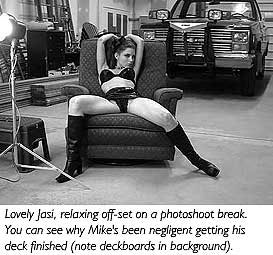
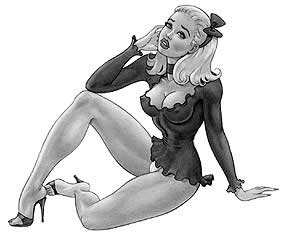

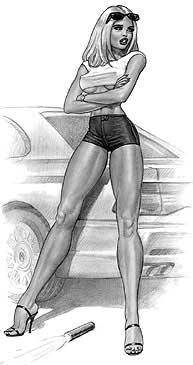


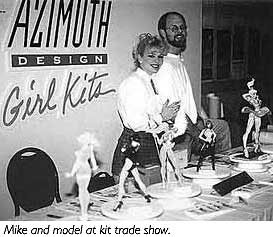
|

